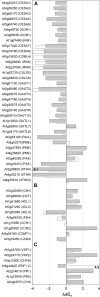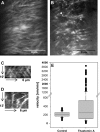Thaxtomin A affects CESA-complex density, expression of cell wall genes, cell wall composition, and causes ectopic lignification in Arabidopsis thaliana seedlings
- PMID: 19269997
- PMCID: PMC2652064
- DOI: 10.1093/jxb/ern344
Thaxtomin A affects CESA-complex density, expression of cell wall genes, cell wall composition, and causes ectopic lignification in Arabidopsis thaliana seedlings
Abstract
Thaxtomin A, a phytotoxin produced by Streptomyces eubacteria, is suspected to act as a natural cellulose synthesis inhibitor. This view is confirmed by the results obtained from new chemical, molecular, and microscopic analyses of Arabidopsis thaliana seedlings treated with thaxtomin A. Cell wall analysis shows that thaxtomin A reduces crystalline cellulose, and increases pectins and hemicellulose in the cell wall. Treatment with thaxtomin A also changes the expression of genes involved in primary and secondary cellulose synthesis as well as genes associated with pectin metabolism and cell wall remodelling, in a manner nearly identical to isoxaben. In addition, it induces the expression of several defence-related genes and leads to callose deposition. Defects in cellulose synthesis cause ectopic lignification phenotypes in A. thaliana, and it is shown that lignification is also triggered by thaxtomin A, although in a pattern different from isoxaben. Spinning disc confocal microscopy further reveals that thaxtomin A depletes cellulose synthase complexes from the plasma membrane and results in the accumulation of these particles in a small microtubule-associated compartment. The results provide new and clear evidence for thaxtomin A having a strong impact on cellulose synthesis, thus suggesting that this is its primary mode of action.
Figures




References
-
- Bernal AJ, Jensen JK, Harholt J, et al. Disruption of ATCSLD5 results in reduced growth, reduced xylan and homogalacturonan synthase activity and altered xylan occurrence in Arabidopsis. The Plant Journal. 2007;52:791–802. - PubMed
-
- Boerjan W, Ralph J, Baucher M. Lignin biosynthesis. Annual Review of Plant Biology. 2003;54:519–546. - PubMed
-
- Braam J. If walls could talk. Current Opinion in Plant Biology. 1999;2:521–524. - PubMed
-
- Brett C, Waldron K. Physiology and biochemistry of plant cell walls. In: Black M, Chapman J, editors. Topics in plant physiology. London: Unwin Hyman; 1990. pp. 6–57.
Publication types
MeSH terms
Substances
LinkOut - more resources
Full Text Sources
Other Literature Sources
Molecular Biology Databases

